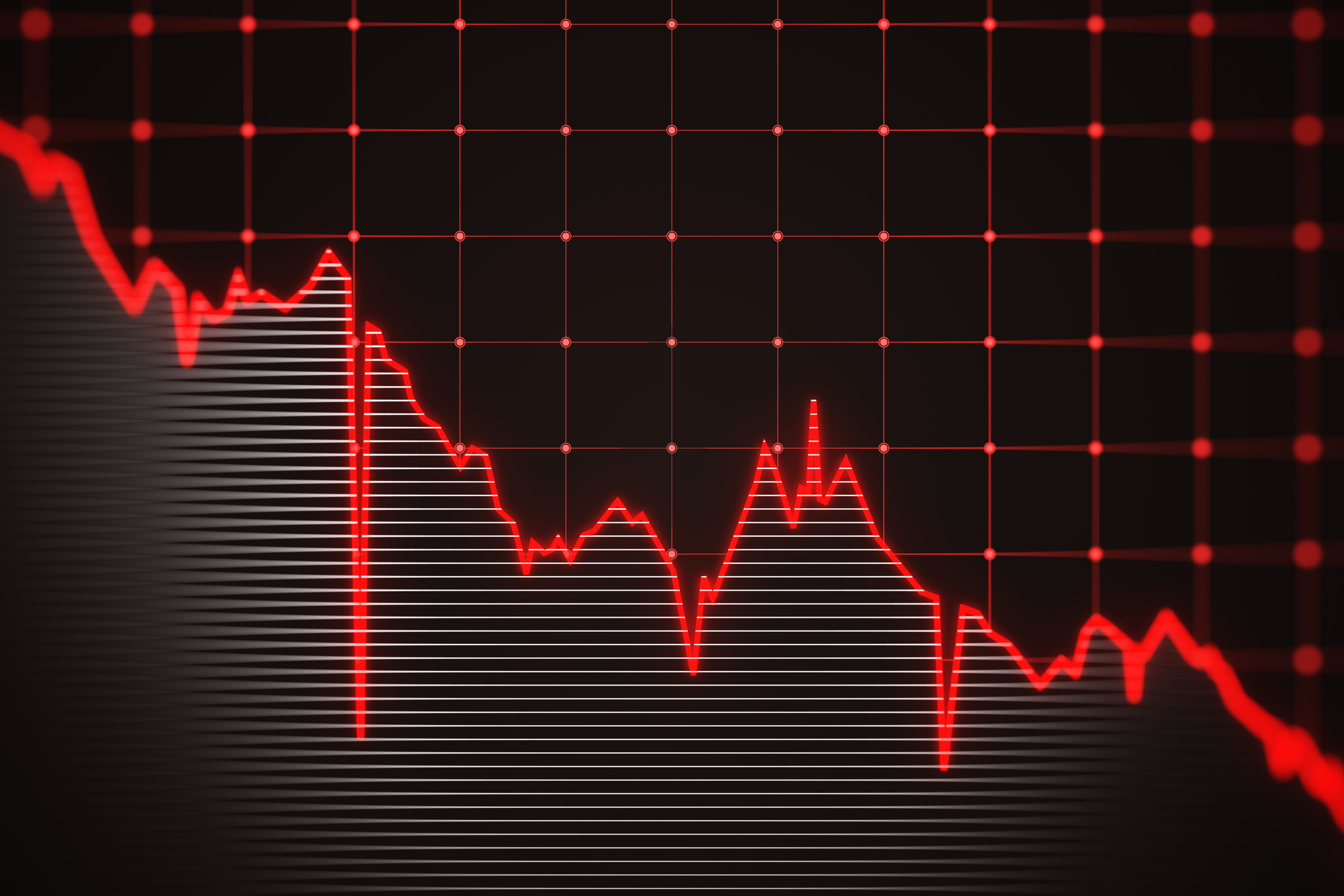4 Key Indicators to Monitor for Signs of a Looming Recession
While investors don't need to panic, they should keep their fingers on the pulse of the economy just to be prepared. Here are four symptoms to keep an eye on.


Uncertainty grips Wall Street and Main Street alike, rendering fears of a larger pullback in business spending and investments. There are many contributing factors for these reasons of worry, including the U.S.-China trade war, Brexit and the "Japanification" of Europe. Additionally, the American government, corporate and consumer debt levels have reached all-time-highs.
Although economies never grow in a straight line, and investors can take comfort in the knowledge that peaks and valleys are only natural, many economists see these as warning signs for a brewing recession.
Between signs of global economic slowdown, escalations in the U.S.-China trade war, negative interest rates in Europe and Japan, unchecked national debt and the longest bull market in U.S. history, investors have plenty of reasons to worry and suspect an imminent recession at the onset of every market pullback.

Sign up for Kiplinger’s Free E-Newsletters
Profit and prosper with the best of expert advice on investing, taxes, retirement, personal finance and more - straight to your e-mail.
Profit and prosper with the best of expert advice - straight to your e-mail.
Recession Sign No. 1: The Fear Factor
Numerous reports recognize that the current unstable environment is treacherous for national and global business:
- Bank of America's economists believe there is a 1 in 3 chance of a 2020 recession. It concedes its formula fails to account for unpredictable factors like the trade war.
- Yahoo! Finance surveyed 100 real estate and economic experts, and half of them predict a 2020 recession.
- CNBC reported that Google searches for the word "recession" quadrupled in August 2019.
Recession Sign No. 2: Falling Consumer Confidence
The CNBC report shows American consumers are worried, which may lead to a retrenchment in consumer confidence and spending. Considering that consumer spending accounts for 68% of the U.S. economy, consumer confidence is a key factor for investors to watch.
Yet despite recession fears and downward trends in manufacturing and corporate capital expenditures, consumer confidence has remained a bright spot as of August 2019. The consumer confidence index was close to its highest level in 19 years, with only a slight drop between July (135.8) and August (135.1).
A score above 100 means consumers feel optimistic and can be expected to spend more. When the score dips below 100, consumers are pessimistic and likely to restrict spending.
Recession Sign No. 3: A Worsening Trade War
During the summer of 2019, nothing stoked more uncertainty than the U.S./China trade war. A quick fix is unlikely because the complexities of the trade relationship create so many points of contention. Much of the hope for a deal comes from the pressure both sides feel.
China's GDP is in decline. Tariffs, as they take their increasing effect, can be expected to harm the all-important U.S. consumer confidence, which has the potential to start the snowball that leads to lower business investment, lost jobs, credit defaults and, in a circular fashion, even lower consumer confidence.
That nightmare scenario is by no means inevitable or even more likely than a moderate slowing that reverses once a deal is reached. In fact, the governments of both countries are taking actions to prevent the trade war from doing serious economic damage, such as keeping interest rates low, cutting interest rates further and exploring a cut in payroll taxes.
These measures may help in the interim, but uncertainty will remain. Much of the economic boom has depended on trade relationships, so investors should consider any threats to them carefully.
Recession Sign No. 4: The Yield Curve
An inverted yield curve is a strange phenomenon that occurs when interest rates essentially turn upside down. Yields on longer-term bonds are lower than shorter-term bonds, which is an illogical situation that often results from investor fear and uncertainty.
Fear and uncertainty were absolutely driving factors of the August inversion of the U.S. two-year and 10-year notes. An inverted yield curve often precedes a recession since it singals that investors see more risk in the short run than the long run. Historicaly, it’s the canary in the mine for lower growth and inflation ahead.
While the yield curve merits monitoring, its predictive value cannot be assessed in isolation of global trends. Central banks outside of the U.S. continue to stimulate their economies by cutting interest rates into negative territory. As a result, 10-year bonds in Germany, France and Japan trade at negative yields, in effect charging investors a storage fee for the privilidege of investing with them.
International investors seeking some return, have fueled demand for 10-year U.S. Treasury notes, putting downward pressure on the long end of the yield curve. Concurrently, the Federal Reserve until recently has shown reluctance to cut rates, keeping the short end of the yield curve boyant.
The Bottom Line: What Investors Can Do
Whatever investors do in this time of uncertainty, there is one thing they should not do, and that is panic. The uncertainty is unlikely to go away soon, but that by no means makes a recession imminent.
The reality is that the U.S. economy continues to chug along, and a trade deal has the potential to spark a rally. But there is no certainty that a deal will be had, or that some other event will not unhinge the markets. This is no time to practice passive investing.
Investors must actively stay in touch with the pulse of the market and economy. Only then can they avoid emotional buying and selling. They should expect volatility and rely on a sound financial strategy to be their best defense when markets roil. Volatility in financial markets is a case of when and not if it happens.
Securities offered through National Securities Corporation, member FINRA/SIPC. Advisory services offered through National Asset Management, an SEC registered investment adviser. Fixed Insurance Products offered through National Insurance Corporation.
Get Kiplinger Today newsletter — free
Profit and prosper with the best of Kiplinger's advice on investing, taxes, retirement, personal finance and much more. Delivered daily. Enter your email in the box and click Sign Me Up.

Ephie Coumanakos is the co-founder and managing partner of Concord Financial Group and a graduate of The Wharton School of The University of Pennsylvania. She specializes in the areas of retirement and pre-retirement planning, asset preservation, wealth management and estate planning. Ephie frequently appears as a speaker at financial workshops in the areas of retirement and estate planning, asset preservation strategies and tax management.
-
 Should You Get Earthquake Insurance?
Should You Get Earthquake Insurance?Standard home insurance doesn’t cover earthquakes, but paying extra for earthquake insurance isn’t just for Californians.
By Rachael Green
-
 Stock Market Today: Dow Drops 699 Points After Powell Speech
Stock Market Today: Dow Drops 699 Points After Powell SpeechFed Chair Powell warned of a slowing economy and higher inflation but said the central bank isn't ready to cut rates just yet.
By Karee Venema
-
 A QLAC Does So Much More Than Simply Defer Taxes
A QLAC Does So Much More Than Simply Defer TaxesHere are the multiple ways you can use a QLAC, from managing retirement risks to creating income for specific retirement needs and wants.
By Jerry Golden, Investment Adviser Representative
-
 Self-Directed Brokerage Accounts: Retirement's Hidden Gem?
Self-Directed Brokerage Accounts: Retirement's Hidden Gem?SDBAs are often overlooked, but they can offer more flexibility and growth potential inside your 401(k) when actively managed by a professional.
By Scott M. Dougan, RFC, Investment Adviser
-
 Early-Stage Startup Deals: How Does a SAFE Work?
Early-Stage Startup Deals: How Does a SAFE Work?Investing in an early-stage startup can get complicated fast, so the venture capital industry turns to other investing options. One is a SAFE.
By Murat Abdrakhmanov
-
 Should You Hire a Public Adjuster for Your Insurance Claim?
Should You Hire a Public Adjuster for Your Insurance Claim?As natural disasters strike more often, insurance clients are asking, 'What should I do, or who should I hire, if my insurance company is jerking me around?'
By H. Dennis Beaver, Esq.
-
 Tips to Help Entrepreneurs Create Self-Sustaining Businesses
Tips to Help Entrepreneurs Create Self-Sustaining BusinessesWith the right processes and people in place, a truly sustainable business can be efficiently passed on to a successor and run profitably on its own.
By Jason L Smith, CEP®, BPC
-
 Navigating Annuity Taxation: A Guide for Financial Advisers
Navigating Annuity Taxation: A Guide for Financial AdvisersUnderstanding the essentials of taxation in retirement income strategies involving annuities helps ensure positive outcomes for clients.
By Jake Klima
-
 How Google Reviews Can Help (or Hurt) Financial Advisers
How Google Reviews Can Help (or Hurt) Financial AdvisersDon't leave your Google Business Profile unclaimed — someone else can make changes if they claim it. Also, here's what you can (and cannot) do with the reviews.
By Jeff Briskin
-
 How Baby Boomers and Gen Xers Are Redefining Retirement Living
How Baby Boomers and Gen Xers Are Redefining Retirement LivingBoth generations need to embrace change and leverage real estate as a dynamic asset in their retirement planning. Here's how financial advisers can help, too.
By David Conti, CPRC